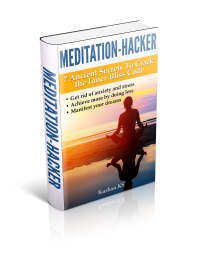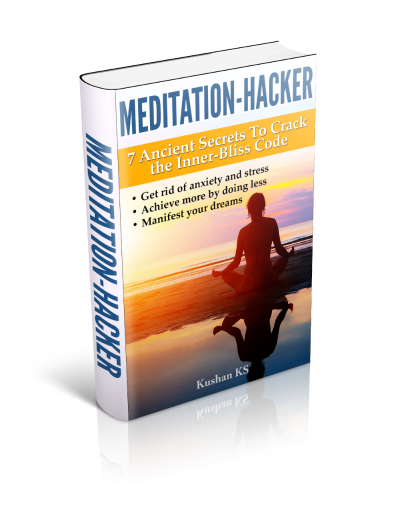Primordial Sound Meditation
"Let Om be the bow, mind the arrow, and higher consciousness the target. Those who want enlightenment should reflect on the sound and the meaning of Om. When the arrow is released from the bow, it goes straight to the target." - Dhyana Bindu Upanishad

Primordial sound meditation is based upon chanting of Om or Aum, the eternal syllable.
The Upanishads state that Om is the primordial or the 'first' sound of the universe generated by the cosmic vibration that resulted in all creation (think Big Bang).
It is the supreme absolute and runs through the prana.
Paramhansa Yogananda, who popularized kriya yoga in the West, called Om, "The creative voice of God, the vibration of the cosmic motor."
Before we discuss the various ways in which we can do primordial sound meditation, here is how you pronounce Om or Aum.
The 'O' or 'AU' is said externally and the 'M' is allowed to reverberate internally.
The first half of 'O' or 'A' starts in the chest at the anahata chakra, moves upward with the second half of 'O' or 'U' to the vishuddha chakra in the throat and ends with 'M' vibrating the ajna and sahasra chakras in the head.
Three ways in which you can practice primordial sound meditation are:
Steven Sturgess' technique
Steven mentioned a very simple way of practicing Om meditation in his Yoga Book.
- chant Om aloud for ten minutes,
- chant Om in a whisper for the next ten minutes, and then
- mentally chant Om for another ten minutes
Finally, be still and meditate on the spiritual eye (the point between the eyebrows).
Surrender yourself to the vibrations of Om and feel your awareness expand.
Paramhansa Yogananda's technique
The author of the bestselling Autobiography of a Yogi illustrates how to do primordial sound meditation in a yogic way.
- close yourself to outside distractions by covering your eyes and ears
- place your thumbs over the ear openings, little fingers over the lowered eyelids and the remaining fingers on the forehead
- turn eyeballs upward and inward, converging your gaze at the central point in the forehead, slightly above and in-between the eyebrows
- mentally chant Om, Om... without making any sound or moving the tongue
- lookout for any sound you may hear
- focus all your attention on listening to any vibrations emanating within
- become one with them
Keep a small bench to support your elbows if you feel tired. It is important that you keep your ears and eyes covered at all times while doing this meditation.
In time, you will start to discern the physical vibrations first followed by the astral vibrations and then finally the sound of Om resonating like a mighty ocean.
What are the different vibrations that one can expect to hear?
Different cerebra-spinal centers or chakras emit different vibrations. For example, the coccygeal (mooladhara) chakra at the base of the spine emits a humming sound. The sacral centre or the swadhishthana chakra has a flute-like sound. Lumber centre (manipura chakra) sounds like a harp and the dorsal centre (anahata chakra) has a bell-like sound.
Cervical (vishuddha chakra) sounds like rushing water and the medulla oblongata (ajna chakra) is the symphony of all sounds together.
Do this meditation for 10 minutes in the morning and for 20 minutes before sleeping.
Regular practice will instill in you a deep calmness and great intuitive ability, which in turn will help in dealing with life situations better.
Ancient beej mantra technique as popularized by Deepak Chopra
This meditation involves chanting of "Om beej (seed) mantra namah!"
The beej or the seed mantra is derived from the sound of each individual's nakshatra-pada. Nakshatra is one of the 27 sectors along the ecliptic covering 13 degrees and 20 minutes, while pada is one quarter of the nakshatra covering 3 degrees and 20 minutes.
The position of the moon at the time of a person's birth determines his or her nakshatra-pada, thus making the seed mantra unique to that person.
The sound of the nakshatra-pada is suffixed with 'm' to arrive at the individual's own primordial sound mantra.
You can find your nakshatra here (link opens in new window) by entering your date, time and place of birth.
Once you have your nakshatra ready, all you need is your pada to derive your beej mantra. Look at the start and end times mentioned along with your nakshatra and divide the period between the two into four equal quarters. Then check for the quartile in which your particular time of birth falls. This will be your pada.
Now use this table to find your own unique beej mantra.
| # | Name | Pada 1 | Pada 2 | Pada 3 | Pada 4 |
|---|---|---|---|---|---|
| 1 | Ashwini | Chu | Che | Cho | La |
| 2 | Bharani | Li | Lu | Le | Lo |
| 3 | Kritika | A | I | U | E |
| 4 | Rohini | O | Va/Ba | Vi/Bi | Vu/Bu |
| 5 | Mrigashīrsha | Ve/Be | Vo/Bo | Ka | Ke |
| 6 | Ārdrā | Ku | Gha | Ng/Na | Chha |
| 7 | Punarvasu | Ke | Ko | Ha | Hi |
| 8 | Pushya | Hu | He | Ho | Da |
| 9 | Āshleshā | Di | Du | De | Do |
| 10 | Maghā | Ma | Mi | Mu | Me |
| 11 | Pūrva Phalgunī | Mo | Ta | Ti | Tu |
| 12 | Uttara Phalgunī | Te | To | Pa | Pi |
| 13 | Hasta | Pu | Sha | Na | Tha |
| 14 | Chitra | Pe | Po | Ra | Ri |
| 15 | Svātī | Ru | Re | Ro | Ta |
| 16 | Viśākhā | Ti | Tu | Te | To |
| 17 | Anurādhā | Na | Ni | Nu | Ne |
| 18 | Jyeshtha | No | Ya | Yi | Yu |
| 19 | Mula | Ye | Yo | Bha | Bhi |
| 20 | Pūrva Ashādhā | Bhu | Dha | Bha/Pha | Dha |
| 21 | Uttara Aṣāḍhā | Bhe | Bho | Ja | Ji |
| 22 | Śrāvaṇa | Ju/Khi | Je/Khu | Jo/Khe | Gha/Kho |
| 23 | Śrāviṣṭha or Dhanishta | Ga | Gi | Gu | Ge |
| 24 | Shatabhisha | Go | Sa | Si | Su |
| 25 | Pūrva Bhādrapadā | Se | So | Da | Di |
| 26 | Uttara Bhādrapadā | Du | Tha | Jha | Da/Tra |
| 27 | Revati | De | Do | Cha | Chi |
For example, if you were born in New York City on January 1, 1970 at 5.30pm, your nakshatra will be Chitra and pada will be 2, making your seed mantra Po and your personal primordial sound meditation mantra: Om Pom Namah!
Begin your meditation with:
- observing a minute of silence with closed eyes
- start chanting the mantra gently for 10-15 minutes
- finish by sitting still for a couple of minutes with no chanting toward the end
Primordial sound meditation, like all other meditations, needs to be done effortlessly without taxing yourself either physically or mentally.
The idea is not to force yourself into chanting the mantra in a set fashion or at a certain pace. Let the tempo of the mantra flow naturally - it may be long or short, fast or slow, loud or soft.
Do not resist any thoughts that may flood your consciousness and
distract you from the chanting. Let them come and go.
Just be one with whatever you experience.
There are people who believe in charging money for giving you your beej mantra. I, on the other hand, believe that something as divine and as natural as the primordial sound meditation should be free and available to all.
Nature's gifts to us - sunshine, air and water are free, so should be meditation in all its forms.
Most Popular...
Return from Primordial Sound Meditation to Meditation Techniques
Return from Primordial Sound Meditation to Home

Get my book, Meditation-Hacker: 7 Ancient Secrets to Crack the Inner-Bliss Code and receive valuable information on meditation that you can use to improve the quality of your health and life.






Comments
I would love to hear your meditation experiences. And, if you are a beginner, your questions and apprehensions about meditation. Comment below or contact me directly through the navigation bar on the left of this page.